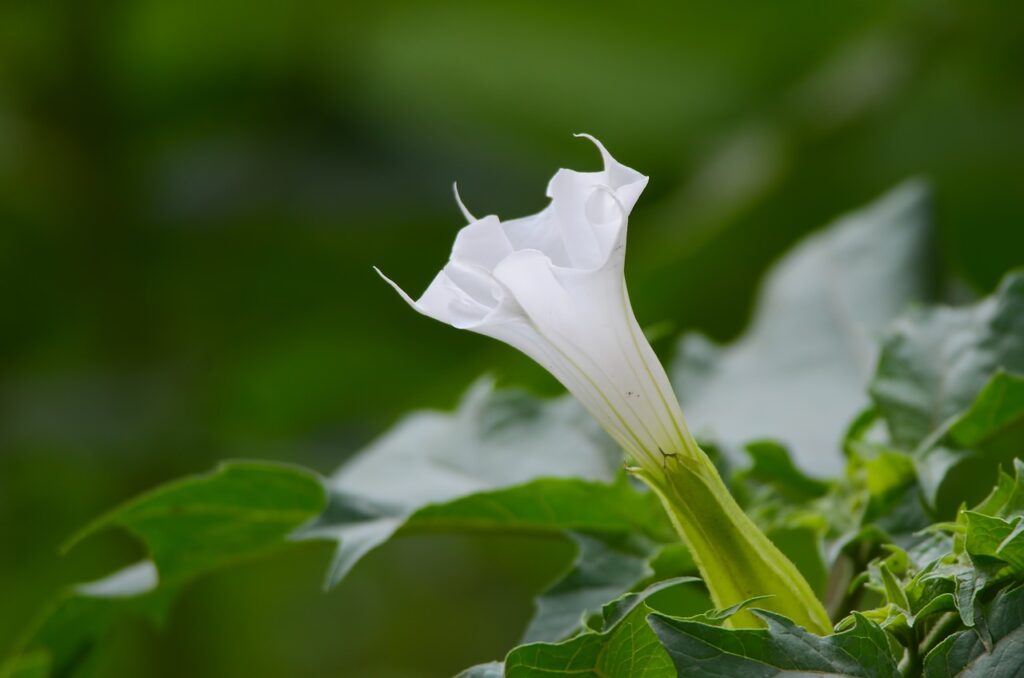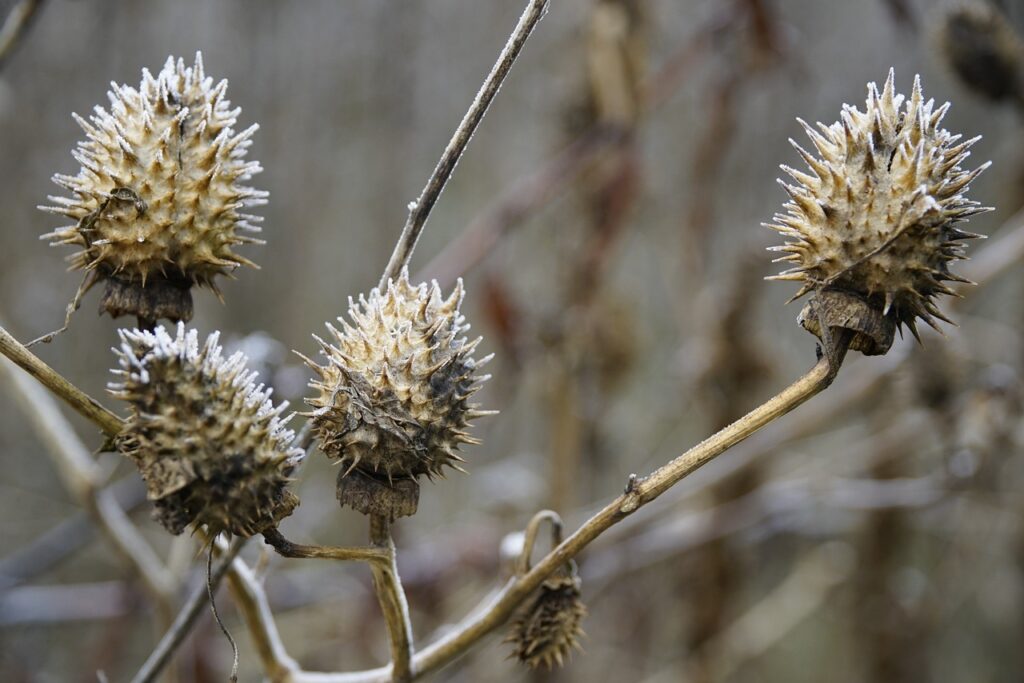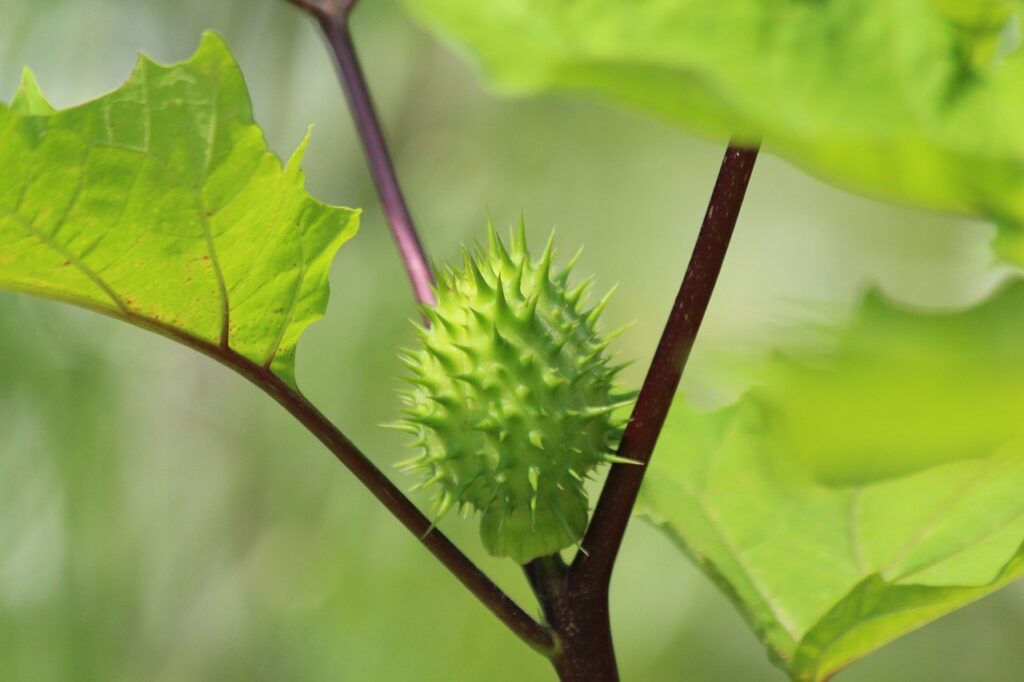An Overview of Datura
Datura, also known as Jimsonweed or Thorn Apple, is a plant of immense cultural, spiritual, and medicinal importance. Revered in Hindu mythology, it is sacred to Lord Shiva, symbolizing purification and power.
Known for its strong fragrance, trumpet-shaped flowers, and spiny seed pods, Datura holds significance in traditional medicine for treating asthma, pain, and spasms. However, its potent alkaloids make it highly toxic, demanding cautious use. Found abundantly in India and globally, Datura thrives in dry, wasteland regions.
Beyond its beauty and utility, this plant’s mystique lies in its dual nature—healing when respected, harmful when misused.

Have you ever encountered a plant that seems to whisper secrets of both exquisite beauty and hidden peril? One that possesses a history steeped in captivating lore and an aura of profound mystery? I’m speaking of Datura stramonium, often called Jimsonweed or Devil’s Snare, and sometimes, though inaccurately, referred to as Astura atramonium.
Table of Contents
This plant exists in a liminal space, both alluring and alarming, beckoning us to explore its depths while simultaneously urging caution. Within this post, we shall embark on a detailed exploration of this enigmatic species, examining its botanical intricacies, its historical applications, and, most importantly, emphasizing the critical necessity of comprehending its potent and perilous toxicity. We will be discussing traditional uses, but please do not interpret this as medical guidance nor endorsement, but rather as shared historical information.
Datura with Uses and Benefits
| Chemical Component | Uses | Benefits |
|---|---|---|
| Atropine | Used in eye drops to dilate pupils; treats bradycardia (slow heart rate). | Relieves eye strain and enhances medical imaging clarity; regulates heart rate. |
| Scopolamine | Prevents motion sickness; treats nausea and vomiting. | Provides relief from motion-related discomfort; reduces vertigo symptoms. |
| Hyoscyamine | Treats gastrointestinal disorders like irritable bowel syndrome (IBS) and peptic ulcers. | Eases abdominal cramping, improves digestion, and reduces stomach acidity. |
| Tropane Alkaloids | Acts as a muscle relaxant and antispasmodic agent. | Alleviates muscle spasms and promotes relaxation. |
| Flavonoids | Possess antioxidant and anti-inflammatory properties. | Protects cells from oxidative stress and supports immune health. |
| Coumarins | Used in anticoagulant therapies; supports cardiovascular health. | Improves blood flow and reduces the risk of blood clots. |
| Phenolic Compounds | Offer antimicrobial and anti-inflammatory effects. | Supports wound healing and protects against bacterial infections. |
| Essential Oils | Found in the seeds and leaves; used in aromatherapy and topical applications. | Promotes relaxation, alleviates pain, and enhances mood. |
Note: Datura’s components are highly toxic and should only be used under strict medical supervision. Misuse can lead to severe health risks.
A Close Look: Astura stramonium’s Botanical Characteristics
Datura stramonium, commonly known by names such as Jimsonweed, Devil’s Snare, or Thorn Apple, belongs to the Solanaceae family, otherwise known as the nightshade family. It’s a plant that commands our attention. Its leaves are expansive, oval-shaped, and coarsely serrated, displaying a somewhat sinister, deep green shade. And the flowers?.
They present an arresting visual—large, trumpet-shaped, and typically displaying hues of white or lavender, often releasing a subtle, at times almost unnoticed, cloyingly sweet aroma, especially noticeable during the evening hours. Though not remarkably fragrant, its blossoms possess an undeniable charm, a façade of beauty concealing a profound and potentially harmful secret.
This plant grows quite tall, reaching heights of one to five feet, and often appears weedy in its overall presentation. Datura possesses a distinctive growth pattern, with thick and robust stems, and large, showy foliage and blossoms that grow erect from the plant’s core as if reaching skyward.

Now let’s clarify the confusion surrounding the alternative name, “Astura atramonium.” Although occasionally used interchangeably with stramonium, it is not a scientifically valid synonym. This misnomer stems from historical and regional inaccuracies, a case of applying an old name for a similar species to the wrong plant. Thus, while you may encounter the name Astura atramonium, the correct and universally recognized scientific designation is stramonium.
Distinguishing Datura stramonium from its Datura relatives is vital. It is sometimes confused with its innoxia (downy thorn apple), which boasts comparable white flowers but displays leaves that are noticeably smoother and softer, and seed pods that are considerably larger.
Additional look-alikes include it’s metel, which presents a comparable overall form, yet is more commonly found in warmer climates and tends to produce more colorful blossoms, often in shades of purple. Nevertheless, all species within the its genus share a fundamental characteristic: they are all toxic.
A Journey Through History and Culture: The Legacy of Datura
Across diverse cultures and throughout the annals of history, stramonium has occupied a variety of roles. Historically, some groups utilized very small, carefully administered amounts for pain relief or to induce altered states of consciousness.
(Again, we emphasize that we do not endorse this practice and it should be done only under very specific guidance). Its ceremonial applications, especially within rituals of initiation and divinatory practices, are well-documented. Certain cultures viewed it as a portal to spiritual dimensions, whereas others harbored apprehension regarding its volatile and unpredictable consequences.
In the realm of folklore, it stands as a symbol of paradox, being associated with witchcraft and magic, and also with concepts of metamorphosis and heightened awareness. The idea that it and other nightshade species were included in the infamous “flying ointments” of lore is still widely known.
In artistic and literary depictions, the image of it carries a dualistic significance, wherein its allure is often interwoven with themes of danger, deceit, and the obscured aspects of human nature. Its presence is used to represent the subtle divide between sanity and madness.
Unveiling the Dark Side: Acknowledging the Toxicity of Datura
Here we arrive at the pivotal point of our exploration: stramonium is an exceedingly toxic plant. Its dangerous nature arises from the presence of tropane alkaloids, most notably hyoscyamine, scopolamine, and atropine. These compounds have profound impacts on the nervous system, causing an array of disturbing and potentially fatal side effects.
Symptoms of Datura Poisoning Include:
- Pupil dilation (frequently causing blurred vision)
- Severe dryness of the mouth and skin
- Rapid and erratic heartbeat
- Restlessness, confusion, and vivid hallucinations
- Abnormally elevated body temperature
- Muscle weakness and spasms
- In extreme cases, coma, respiratory failure, and ultimately death.
A Critical Warning: it is unequivocally not a plant for recreational or experimental use. Its effects are highly unpredictable, and the line separating a perceived “therapeutic” dose from a fatal one is infinitesimally narrow. Under no circumstances should any part of this plant be ingested. This applies to humans and pets equally.
First Aid Protocol: If its poisoning is suspected, it’s absolutely imperative to seek immediate medical intervention. Do not induce vomiting unless specifically instructed by a healthcare professional, and provide all available information about the suspected ingestion to medical personnel.
A Word on Cultivation (Emphasizing Caution):
Should you be contemplating growing it, I urge you to proceed with the utmost caution. The plant’s aesthetic appeal should not distract from its very high danger, especially in a home environment where children or pets might be present, or where individuals may be susceptible to unintentional ingestion.
- Cultivation Needs: it thrives in well-drained soil and direct sunlight. It is a rather resilient plant, tolerant of relatively poor soil conditions.
- Propagation Methods: It’s typically propagated from seeds, started indoors early in spring, or sown directly outdoors when the threat of frost has subsided.
- Paramount Safety Precaution: Keep it secured in an inaccessible space, away from children and pets. It’s recommended that you wear protective gloves when handling the plant and always wash your hands thoroughly afterward. For individuals without specific knowledge, the recommendation is to not grow it at all due to the risks.
Legal and Ethical Considerations:
In many regions, it is classified as a controlled substance, with laws dictating its cultivation, distribution, and possession. Before growing it, always familiarize yourself with local laws. Ethically, cultivating and handling such a potent plant carries significant responsibility, necessitating vigilant control to prevent its misuse.
Seeking Similar Aesthetics with Safety in Mind:
If you’re drawn to the beauty of it but would prefer a safer alternative, consider plants with comparable trumpet-shaped blossoms and deep green foliage, such as:
- Morning Glories: These climbing vines display a diverse array of vividly colored blossoms.
- Nicotiana: Although part of the nightshade family, Nicotiana is most often grown for the aesthetic appeal of its flowers; compared to tobacco varieties it produces only trace amounts of nicotine.
Top 15 Benefits of Datura
The subsequent list of “benefits” is purely rooted in historical and traditional practices, many of which are considered to be extremely dangerous in current days. This information is NOT intended to endorse any contemporary uses, and any attempts to self-administer for these reasons is incredibly hazardous. This list is here to highlight how the plant has been used in the past.

- Pain Management (Historically): In various cultures, very small amounts of it were used for pain alleviation, particularly related to muscles and bones. This can result in severe poisoning.
- Surgical Anesthesia (Crude): it was used as an early, very risky form of anesthetic for surgery in some cultures. This practice was very dangerous.
- Altered States: Some groups employed in rituals, trying to achieve altered states of consciousness. This is highly dangerous.
- Asthma Treatment (Traditional): It was used (in very dangerous and risky ways) in Ayurveda medicine for asthma due to the bronchodilating action of atropine.
- Wound Treatment (Traditional): it was used to treat wounds and swellings. This has no scientific validity.
- Antispasmodic: Used in old cultures for muscle cramping and spasms, this was usually with a topical application.
- Sedative/Hypnotic: it was used in traditional practice to induce sleep. This is very dangerous due to potential for overdose.
- Delirient: To induce a state of delirium for perceived spiritual purposes. This is incredibly dangerous.
- Aphrodisiac (Historically): As an ancient belief, it was used as an aphrodisiac. This is incredibly dangerous.
- Epilepsy Treatment: Some old medicines have made use of Datura for epilepsy. This is very dangerous and has no scientific basis.
- Cough Treatment: The plant was used as a traditional cough remedy.
- Rheumatism Treatment: Made into a poultice in some cultures to relieve achy joints.
- Labor Induction: There is some unconfirmed historical information that it was used to induce labor. This is very dangerous for both mother and child.
- Poisoned Weapons: Some cultures have been known to use it as a poison for weapons. This is incredibly dangerous and should never be attempted.
- Divination: The altered state caused by the use of it was used by some as a method for fortune-telling. This is incredibly dangerous and should never be attempted.
Gendered Uses (Historical Perspectives)
While gendered uses aren’t very well documented, what is available is listed below. As stated earlier, please note that these were not specific to only one gender, but more about how each gender could be affected by them.
- Women during Childbirth: it was used historically in the management of pain during childbirth and sometimes to induce labor.
- Men in Rituals: Historically, men were often the participants in ceremonies that made use of the altered states induced by it.
The information we provided about historical use cases is solely for educational and informational purposes. It is essential that you do NOT attempt to use of stramonium for any reason due to its high level of toxicity and the unpredictable nature of its effects. Please always consult with a medical professional when you have any medical issues. THIS IS NOT MEDICAL ADVICE OR ENDORSEMENT OF ANY KIND.
Chemical and Nutritional Components Table of Datura
Please remember that the table is not to suggest that Datura is useful, and that the focus is on its toxic components only for educational purposes.
| Component | Details | Notes |
| Tropane Alkaloids | Hyoscyamine, Scopolamine, Atropine | These are the primary toxins; levels vary in the plant. |
| Other Alkaloids | Small amounts of other related alkaloids may be present | |
| Water | High water content | |
| Other | trace amounts of various minerals and trace elements; very small amount of fats, etc | Not considered in any way relevant in nutritional terms as this plant is not safe to consume |
NOTE: DO NOT ATTEMPT TO EXTRACT OR PROCESS ANY CHEMICALS FROM THIS PLANT
Have you ever encountered Datura or Jimsonweed? Please share your thoughts and any insights in the comments. We also welcome and recommend you share resources for educational purposes only. It is always important to prioritize safety while responsibly expanding our knowledge about potentially dangerous species.
Conclusion:
Stramonium, or the misnamed Astura atramonium, is a plant that demands profound respect. Its history is intricate, its beauty undeniable, yet its toxicity is undeniable. Continue to seek knowledge while remaining mindful of the potential dangers, and always share information responsibly.
Datura: Know More Quickly
- Which drug is obtained from Datura?
it contains alkaloids like atropine, scopolamine, and hyoscyamine, which are used in medicine for various treatments. - Why is Datura offered to Shiva?
it is considered sacred and is offered to Lord Shiva as it symbolizes the destruction of negativity and purification. - What is the use of Datura fruit?
its fruit is used in traditional medicine to treat asthma, muscle spasms, and as a pain reliever under strict supervision. - Why is Datura offered to Lord Shiva?
In Hindu mythology, it is believed to have emerged from the chest of Lord Shiva during Samudra Manthan, symbolizing his association with it. - Which God is Datura for?
it is primarily associated with Lord Shiva in Hindu mythology and rituals. - Who offered Lord Shiva meat?
As per legends, the demon Andhaka once offered meat to Lord Shiva. - What does Datura smell like?
its flowers have a strong, sweet fragrance, often blooming at night. - What is the natural name for Datura?
The botanical name of it is Datura stramonium, also known as Jimsonweed or Thorn Apple. - How to identify Datura?
its plants are identified by their trumpet-shaped flowers, spiny seed pods, and broad, toothed leaves. - Does Mahadev drink alcohol?
Lord Shiva is often depicted as consuming bhang, but this is symbolic of his transcendence over material and earthly desires. - Who gave pork to Shiva?
In folklore, the demon Andhaka is said to have offered pork to Lord Shiva. - Who is Lord Shiva’s first wife?
Goddess Sati is considered the first wife of Lord Shiva. - Is Datura male or female?
its plants have both male (stamens) and female (pistils) reproductive structures in their flowers, making them hermaphroditic. - How to use Datura for hair growth?
Datura oil or extracts can be applied to the scalp for hair growth, but it must be diluted and used cautiously due to its toxic nature. - Where is Datura found in India?
Datura grows widely across India, particularly in dry, wasteland areas and roadside regions. - What is the specialty of Datura?
Datura is known for its medicinal properties, spiritual significance, and toxic effects if misused. - What is the Datura plant in astrology?
In astrology, Datura is considered a sacred plant that symbolizes protection and the removal of obstacles. - Why is Datura given to Shiva?
It is believed to neutralize negative energies and symbolize devotion. - How to purify Datura?
Datura can be purified by washing it in clean water or sacred rituals before use. - What plant grows hair faster?
Plants like Aloe Vera, Fenugreek, and Hibiscus are known to promote faster hair growth. - Can walnuts stop hair fall?
Yes, walnuts are rich in Omega-3 fatty acids and Vitamin E, which help reduce hair fall and improve hair health. - What is the benefit of Datura fruit?
Datura fruit has medicinal properties for pain relief, treating asthma, and muscle relaxation. - How do you store Datura?
Datura seeds and leaves should be dried and stored in airtight containers away from sunlight. - Which parts of Datura are used in medicine?
The seeds, leaves, and flowers of Datura are used in traditional medicine under expert supervision. - How do you stop Datura poisoning?
Immediate medical attention is crucial. Activated charcoal and supportive care are often used to manage poisoning. - Is Datura self-fertile?
Yes, Datura plants are self-fertile and can pollinate themselves. - Can Datura be transplanted?
Yes, Datura can be transplanted, but it prefers well-drained soil and adequate sunlight. - Is Datura flower male or female?
Datura flowers contain both male and female parts, making them bisexual. - What are companion plants for Datura?
Companion plants like marigold and basil can help deter pests around Datura. - Why is my Datura wilting?
Datura wilts due to overwatering, root rot, or lack of proper sunlight.
